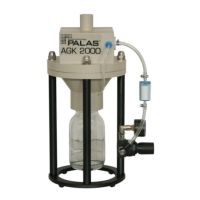6 Troubleshooting
5935-en_V2.0_09/19 23
6 Troubleshooting
6.1 Nozzle Blockages
If solutions and suspensions are used that contain substances solid at room
temperature (e.g. latex particles) or that might crystallize out (e. g.
KCl-solutions), the nozzle might become clogged. The generator should
therefore be operated with distilled water (with a pure solvent respectively) after
every operation, in order to wash out all remaining aerosol substances from the
nozzle. If this shall be done, the liquid reservoir must first be emptied and then
be re-filled with the solvent (distilled water respectively).
When changing the aerosol substance, the cyclone has to be cleaned and dried
carefully. This is most important if you change from hydrophobe to hydrophile
liquids, e. g. from DEHS to a KCl-solution. In this case, the reservoir has to be
cleaned at first and then the generator itself should be cleaned with
Isopropanol. The instrument should be run with Isopropanol for a short time.
The generator must be totally dry when the salt solution is filled in. This state is
reached by running the instrument with compressed air for some time. In
addition, it must be sure that there are no droplets inside the supply air tube.
If the generator is run with highly concentrated KCl solutions for a long time,
there could arise problems concerning the nozzle. They are caused by
sedimentations. Ususally, the problems are solved by running the aerosol
generator with distilled water for a short time. If this is not enough, the nozzle
must be taken out for cleaning purposes. Therefore, the two screws at the
nozzle must be screwn off. Then the nozzle can be pulled out. It is important
that the O-ring is situated at the correct place when the nozzle is put in again.
The O-ring seals the nozzle towards the cyclone.
6.2 Pollution of the aerosol generator
To clean the instrument please firstly removes the material out of the liquid
reservoir. After that, please use distillated water to flash the material out of the
instrument. Therefore please use at least a pre-pressure of 2 bar. For further
information, see the section “Maintenance [▷22]“
For other problems please contact Palas directly if a problem persists or cannot
be resolved with the information from the following sections:
Address:
Palas GmbH
Greschbachstraße 3 b
76229 Karlsruhe
Germany
Note
No components may be serviced or replaced in the aerosol generator AGK
2000 without instruction from a Palas employee. In the event of infringement,
the customer loses their warranty claims; in addition Palas is not liable for the
damage arising.
In case of problems with the aerosol generator AGK 2000, please contact Palas
GmbH (Tel.: 0721/96 213-0).

